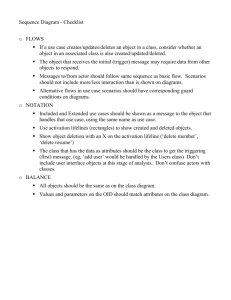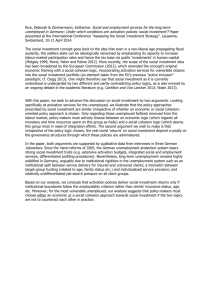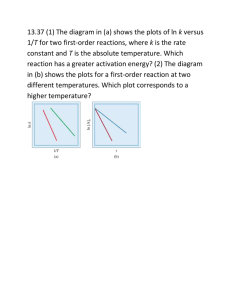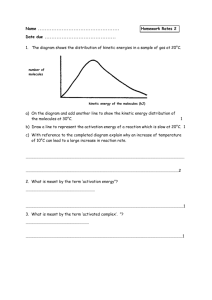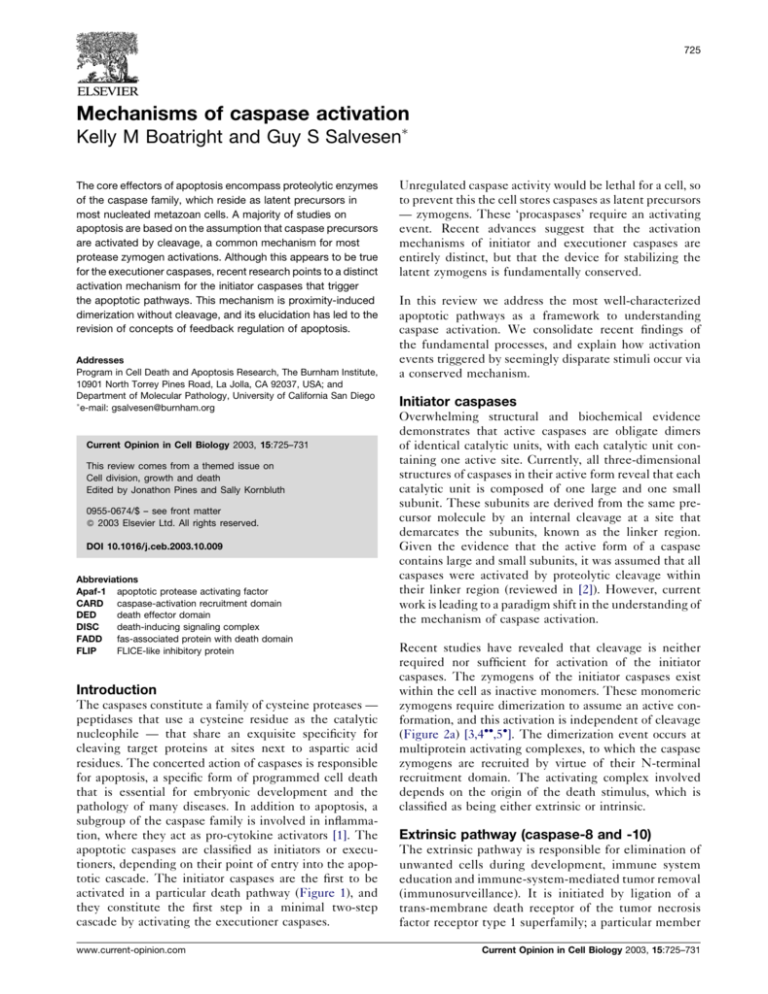
725
Mechanisms of caspase activation
Kelly M Boatright and Guy S Salvesen
The core effectors of apoptosis encompass proteolytic enzymes
of the caspase family, which reside as latent precursors in
most nucleated metazoan cells. A majority of studies on
apoptosis are based on the assumption that caspase precursors
are activated by cleavage, a common mechanism for most
protease zymogen activations. Although this appears to be true
for the executioner caspases, recent research points to a distinct
activation mechanism for the initiator caspases that trigger
the apoptotic pathways. This mechanism is proximity-induced
dimerization without cleavage, and its elucidation has led to the
revision of concepts of feedback regulation of apoptosis.
Addresses
Program in Cell Death and Apoptosis Research, The Burnham Institute,
10901 North Torrey Pines Road, La Jolla, CA 92037, USA; and
Department of Molecular Pathology, University of California San Diego
e-mail: gsalvesen@burnham.org
Current Opinion in Cell Biology 2003, 15:725–731
This review comes from a themed issue on
Cell division, growth and death
Edited by Jonathon Pines and Sally Kornbluth
0955-0674/$ – see front matter
ß 2003 Elsevier Ltd. All rights reserved.
DOI 10.1016/j.ceb.2003.10.009
Abbreviations
Apaf-1 apoptotic protease activating factor
CARD caspase-activation recruitment domain
DED
death effector domain
DISC
death-inducing signaling complex
FADD
fas-associated protein with death domain
FLIP
FLICE-like inhibitory protein
Introduction
The caspases constitute a family of cysteine proteases —
peptidases that use a cysteine residue as the catalytic
nucleophile — that share an exquisite specificity for
cleaving target proteins at sites next to aspartic acid
residues. The concerted action of caspases is responsible
for apoptosis, a specific form of programmed cell death
that is essential for embryonic development and the
pathology of many diseases. In addition to apoptosis, a
subgroup of the caspase family is involved in inflammation, where they act as pro-cytokine activators [1]. The
apoptotic caspases are classified as initiators or executioners, depending on their point of entry into the apoptotic cascade. The initiator caspases are the first to be
activated in a particular death pathway (Figure 1), and
they constitute the first step in a minimal two-step
cascade by activating the executioner caspases.
www.current-opinion.com
Unregulated caspase activity would be lethal for a cell, so
to prevent this the cell stores caspases as latent precursors
— zymogens. These ‘procaspases’ require an activating
event. Recent advances suggest that the activation
mechanisms of initiator and executioner caspases are
entirely distinct, but that the device for stabilizing the
latent zymogens is fundamentally conserved.
In this review we address the most well-characterized
apoptotic pathways as a framework to understanding
caspase activation. We consolidate recent findings of
the fundamental processes, and explain how activation
events triggered by seemingly disparate stimuli occur via
a conserved mechanism.
Initiator caspases
Overwhelming structural and biochemical evidence
demonstrates that active caspases are obligate dimers
of identical catalytic units, with each catalytic unit containing one active site. Currently, all three-dimensional
structures of caspases in their active form reveal that each
catalytic unit is composed of one large and one small
subunit. These subunits are derived from the same precursor molecule by an internal cleavage at a site that
demarcates the subunits, known as the linker region.
Given the evidence that the active form of a caspase
contains large and small subunits, it was assumed that all
caspases were activated by proteolytic cleavage within
their linker region (reviewed in [2]). However, current
work is leading to a paradigm shift in the understanding of
the mechanism of caspase activation.
Recent studies have revealed that cleavage is neither
required nor sufficient for activation of the initiator
caspases. The zymogens of the initiator caspases exist
within the cell as inactive monomers. These monomeric
zymogens require dimerization to assume an active conformation, and this activation is independent of cleavage
(Figure 2a) [3,4,5]. The dimerization event occurs at
multiprotein activating complexes, to which the caspase
zymogens are recruited by virtue of their N-terminal
recruitment domain. The activating complex involved
depends on the origin of the death stimulus, which is
classified as being either extrinsic or intrinsic.
Extrinsic pathway (caspase-8 and -10)
The extrinsic pathway is responsible for elimination of
unwanted cells during development, immune system
education and immune-system-mediated tumor removal
(immunosurveillance). It is initiated by ligation of a
trans-membrane death receptor of the tumor necrosis
factor receptor type 1 superfamily; a particular member
Current Opinion in Cell Biology 2003, 15:725–731
726 Cell division, growth and death
Figure 1
Intrinsic
Extrinsic
Mitochondrial cytochrome c
release and apoptosome assembly
Death receptor ligation and
DISC assembly
Mitochondrion
DISC
Cytochrome c
release
Apoptosome
Procaspase-8
Procaspase-9
Active caspase-9
Procaspase-3, -7
Active caspase-8
Active caspase-3, -7
Current Opinion in Cell Biology
Schematic overview of the apoptotic pathways. Engagement of either the extrinsic or the intrinsic death pathways leads to the activation of the initiator
caspases by dimerization at multiprotein complexes. In the extrinsic pathway, the DISC is the site of activation for caspase-8 and, at least in
humans, caspase-10. The active sites are represented by orange stars. Stimulation of the intrinsic pathway leads to activation of caspase-9 at
the apoptosome. Caspase-9 is shown as having one active site as seen in its crystal structure. However, the number of active sites in vivo is
unknown. Following activation, the initiator caspases then cleave and activate the executioner caspases-3 and -7.
of this family, Fas (also known as CD95 or APO-1), has
become the paradigm for the study of the extrinsic pathway (reviewed in [6]). Upon ligation, the Fas receptor
forms microaggregates at the cell surface, allowing the
adaptor molecule FADD (Fas-associated protein with
death domain) to be recruited to its cytosolic tail by a
multi-step mechanism [7]. FADD recruits caspase-8
zymogens by virtue of homophilic interaction with their
N-terminal death effector domains (DEDs). It is within
this death-inducing signaling complex (DISC) that the
initiator caspase-8 is activated. The initial hypothesis for
activation implicated an induced proximity model,
where a small amount of activity inherent in the procaspase-8 allowed cleavage in trans of caspase-8 dimers
recruited to the confined space of the DISC, thus generating the canonical active two-chain form (reviewed
in [8]).
Current Opinion in Cell Biology 2003, 15:725–731
New data now shed doubt on this mechanism [4,5].
Cleavage appears not to be required for the formation of
an active site. Rather, this cleavage event is thought to
provide stability to the dimer generated during DISC
formation, and the fundamental activation event is dimerization of caspase-8 monomers. Induced proximity still
applies, but in the updated version of the hypothesis it is
the recruitment of monomers to allow dimer formation,
not the recruitment of pre-formed dimers, that is important. Following dimerization to the catalytically active
form, the N-terminal DEDs are proteolytically removed,
presumably allowing the activated caspase to be released
into the cytosol [9].
This activation mechanism relies on a previously unappreciated property of procaspase-8: that in its inactive
state it is a monomer. This property has now been
www.current-opinion.com
Mechanisms of caspase activation Boatright and Salvesen 727
Figure 2
(a)
Dimerization
at a multiprotein
activating complex
(b)
Cleavage
of the interdomain linker
Current Opinion in Cell Biology
Cartoon representation of the two molecular mechanisms of pro-caspase activation. (a) Activation of initiator caspases. The zymogens of
initiator caspases exist as latent monomers. These monomers are activated by dimerization, which allows translocation of the activation loop
(depicted as a red ‘sausage’) into the accepting pocket of the neighboring dimer. The active site is represented by an orange patch. (b) Activation of
executioner caspases. The zymogens of executioner caspases exist as preformed dimers. Their zymogen latency is maintained by steric
hindrances imposed by the interdomain linker (depicted as a yellow ‘banana’). Cleavage of this linker permits translocation of the activation loop,
facilitating formation of the active site. Notice that the fundamental process of activation, translocation of the activation loop, is conserved for both
the initiator and the executioner caspases.
exhaustively demonstrated for both recombinant material
[5] and the natural endogenous zymogen [4]. This is in
stark contrast to the zymogens of the executioner caspases-3 and -7, which are already dimeric in their latent
forms. The explanation for this important difference,
which at first glance is incongruous, is clarified below.
The caspase-8 ortholog caspase-10 is also an initiator in
death-receptor-mediated cell death, at least in humans
(mice apparently lack a caspase-10 gene). There is controversy in the literature regarding the ability of caspase10 to functionally substitute for caspase-8 in death-receptor signaling. Initial work done on caspase-8 deficient
cells derived from the Jurkat T-cell line concluded that
caspase-8 was essential for death-receptor-mediated
apoptosis [10]. However, subsequent studies revealed
that this cell line also had reduced caspase-10 levels
and found that transient transfection of these cells with
caspase-10 was sufficient to sensitize them to deathreceptor-mediated cell death [11,12]. A contrasting study
found that reconstitution of these Jurkat T cells by stable
transfection with the death receptor DR4 in combination
with caspase-10 did not sensitize to death-receptorinduced apoptosis [13]. Given the complications inherent
in reconstitution experiments, it is useful to gain insight
from the lessons learned from humans with caspase-8 and
-10 deficiencies. Humans with mutant caspase-10 exhibit
an autoimmune lymphoproliferative syndrome caused by
defective lymphocyte apoptosis [14]. Humans with
mutant caspase-8, while also exhibiting defects in lymphocyte apoptosis, have in addition pronounced defects
www.current-opinion.com
in their ability to activate lymphocytes, with resulting
immunodeficiency [15]. Significantly, the latter study
revealed that caspase-8 deficiency is compatible with
development in humans, although it is embryonic-lethal
in mice [16]. Taken together, these studies suggest that,
although there is some overlap, caspase-8 and -10 probably have distinct functions.
An interesting addition to the mechanism of caspase-8
activation is the involvement of FLIP (FLICE-like inhibitory protein — FLICE was one of the original names for
caspase-8). FLIP is a caspase-8 homolog with certain
important differences, most notably its lack of a catalytic
cysteine, which renders it incapable of proteolytic activity. Initial reports in the literature were at odds over
whether FLIP was pro- or anti-apoptotic. Overexpression
of FLIP in some cell lines inhibited death-receptormediated apoptosis, presumably by blocking caspase-8
binding sites at the DISC. Work by Chang and colleagues
provided a solution to this apparent conflict by showing
that at low levels of expression (close to those occurring in
a normal cell) FLIP enhances Fas-induced caspase-8
activation at the DISC; only at higher levels (as found in
certain tumors, for example) does FLIP inhibit caspase-8
activation [17]. This study was complemented by studies
revealing that FLIP was capable of forming heterodimers
with caspase-8 that possessed catalytic activity [18], incidentally confirming the dimerization activation mechanism of caspase-8. Further elucidation of this exciting
mechanism for protease regulation within normal and
tumor cells will certainly yield important discoveries.
Current Opinion in Cell Biology 2003, 15:725–731
728 Cell division, growth and death
Intrinsic pathway (caspases-9 and -2)
The intrinsic pathway is used to eliminate cells in
response to ionizing radiation, chemotherapeutic drugs,
mitochondrial damage and certain developmental cues.
Following the death trigger, mitochondria may become
selectively permeabilized, leading to the release of cytochrome c and the recruitment and activation of the apical
caspase of the intrinsic pathway, caspase-9, in a complex
known as the ‘apoptosome’ [19]. The central component
of the apoptosome is a protein known as Apaf-1 (apoptotic
protease activating factor 1), which recruits caspase-9 via
its N-terminal caspase-activation recruitment domain
(CARD) [20]. In its quiescent state, Apaf-1 is a compact
molecule with the head (CARD domain) tucked between
its feet (two b-propellers formed by sets of WD40
repeats). Cytochrome c (which is conveniently about
the same size as the CARD) displaces the head, allowing
the compact structure to stretch out into a more linear
molecule that polymerizes upon binding ATP [21]. The
electron cryomicroscopy studies show the apoptosome to
be a seven-spoked wheel, with a central hub that contains
the caspase-9 recruitment domain, which is provided by
the CARD of Apaf-1. Regrettably, the conformation of
caspase-9 was not visible in the images, but other techniques have suggested a monomer-to-dimer transition
analogous to caspase-8 activation.
Although a monomer at cytosolic concentrations, the
three-dimensional crystal structure of caspase-9 reveals
that the active form is a dimer [22]. Interestingly, this
dimer contains only one active domain as a result of steric
clashes at the dimer interface. The other domain of the
dimer is in a zymogen-like conformation with the specificity determinants and catalytic apparatus disabled.
Importantly, the conformation of the inactive domain is
almost identical to that of the zymogen form of caspase-7,
as described below.
As with caspase-8, not only is cleavage unnecessary for
activation of caspase-9, but also it is insufficient to produce an active enzyme [3,23]. Instead, caspase-9 is activated by small-scale rearrangements of surface loops that
define the substrate cleft and catalytic residues [22]. In
the simplest model, this is achieved by dimerization of
caspase-9 monomers within the apoptosome, with the
dimer interface providing surfaces compatible with catalytic organization of the active site.
Although caspase-9 is the common initiator of the intrinsic pathway, recent work demonstrates that caspase-2 is
required for an apoptotic response to neurotrophic deprivation [24] and DNA damage [25], a subset of intrinsic
stimuli. Caspase-2 appears to be activated by interaction
with a high-molecular-weight complex that requires the
CARD of caspase-2 [26]. The components of this complex have yet to be identified, but it has been shown to be
independent of Apaf-1. Similar to the other initiator
Current Opinion in Cell Biology 2003, 15:725–731
caspases, the zymogen of caspase-2 is a latent monomer
(F Scott, K Boatright and G Salvesen, unpublished data)
and cleavage is not required for its activation [26].
Rather, the active form of caspase-2 exists in both cleaved
and uncleaved states, in complex with a high-molecularweight activator of unknown composition.
Executioner caspases-3 and -7
In stark contrast to the initiators, the executioner caspase3 and -7 zymogens exist within the cytosol as inactive
dimers [4]. They are activated by limited proteolysis
within their interdomain linker, which is carried out by an
initiator caspase or occasionally by other proteases under
specific circumstances (Figure 2b). Caspase-6 is not as
extensively studied as caspases-3 and 7, but is usually
classified as an executioner caspase on the basis of its lack
of a long pro-domain and its presumptive cleavage downstream of the initiators. Additionally, in recombinant form
its zymogen is a dimer [27]. The crystal structures of
zymogen caspase-7, active caspase-7 and inhibitor-bound
caspase-7 serve as a model with which to rationalize the
apparent conflict between the cleavage mechanism for
executioner caspase activation and the dimerization
mechanism for apical caspase activation [28,29,30].
At cytosolic concentrations in human cells, the caspase-3
and -7 zymogens are already dimers, but cleavage within
their respective linker segments is required for activation
[29,30]. The same re-ordering of catalytic and substrate-binding residues as seen in caspase-9 occurs in
caspase-7, indicating that the fundamental mechanism
of zymogen activation is equivalent. Only the driving
forces are distinct: the linker segment of pro-caspase-7
blocks ordering of the active site until cleavage, whereupon the new N- and C-terminal sequences aid in active
site stabilization. The property that allows the distinct
driving forces to converge on the same activation mechanism seems to be the unusual plasticity of the residues
constituting the caspase active site, which rather unusually
for proteases are predominantly placed on flexible loops
and not on regions with an ordered secondary structure.
Why are the executioner caspase zymogens dimeric
whereas the apical caspase zymogens are monomeric at
physiologic concentrations? Part of the reason for this lies
the relatively weak hydrophobic character of the dimer
interface in caspases-8 and -9, which contrasts strongly
with extremely hydrophobic nature of the dimer interface
in caspases-3 and 7. Specifically, the Kd for caspase-3
dimerization is <50 nM [31], which is more than three
orders of magnitude tighter than the Kd for caspase-8
(50 mM) [5].
The executioner caspases-3 and 7 have shorter Nterminal extensions than the initiator caspases, and for
some time the role of these prodomains has remained
elusive. They do not participate in the inherent activation
www.current-opinion.com
Mechanisms of caspase activation Boatright and Salvesen 729
mechanism [32,33], but are apparently important for
efficient activation of the executioners in vivo, possibly
because of spatial sequestration or cellular compartmentalization [33,34].
Conclusions
A combination of biochemistry, structural analysis and
cell biology has led to rapid advances in our understanding of the caspases and has revealed an underlying conservation in caspase activation. Although the initiators
and executioners possess differing mechanisms of activation — dimerization for the initiators and interdomain
cleavage for the executioners — the fundamental
mechanism of zymogen latency is conserved: activation
of both types of caspases requires translocation of an
activation loop. For the executioners, this translocation
is blocked by steric hindrances imposed by the interdomain linker. For the initiators, dimerization must first
occur to allow the activation loop to interact with the
adjacent monomer. We predict that all initiator caspases
should undergo the monomer–dimer activation mechanism, by homodimerization or even heterodimerization (as
proposed for caspase-8 and FLIP [18]). In support of this,
there is data suggesting that proximity-induced activation
may apply to the initiator caspases involved in inflammation. Recent studies reveal that in humans caspases-1 and
-5 seem to assemble in the interleukin-1b activator complex called the ‘inflammasome’ [35], whereas genetic
evidence in mice implicates an interaction between the
orthologous proteins caspases-1 and -11 [36]. Intriguingly,
these may represent examples of heterodimerization as an
important feature of cytokine activation, but this hypothesis awaits some crucial tests.
The revised hypothesis for apical caspase activation has
important consequences for the interpretation of experimental results relating to caspase activity. For example,
most studies interpret the cleavage of a caspase as evidence of its activation. As we discuss this may be valid
only for executioner caspases that are activated by such
cleavage. Certainly, the cleavage of caspase-8 and -9
observed in numerous publications is usually a consequence of their activation, but it is not definitive. Cleavage of an apical caspase may not promote its activity
unless it is already in a dimeric configuration. In this
context, the concept of feedback activation from the
executioners (caspases-3 and -7) to the initiators (caspases-8, -9 and -10) may be invalid. Studies that assume
cleavage of an apical caspase indicates activation should
be evaluated cautiously.
It stands to reason that the initial activating event in a
proteolytic pathway cannot be proteolysis itself. Indeed,
most proteolytic cascades are initiated by cofactor-driven
conformational changes in protease zymogens. In the case
of apoptosis, the specific conformational change driven by
the cofactors (DISC or apoptosome) is dimerization.
www.current-opinion.com
Induced proximity overcomes the energetic barrier for
initiator caspase dimerization to occur by converting a
bimolecular interaction to a unimolecular one. Once you
have generated the first proteolytic signal you can utilize
specific proteolysis to drive forward the cascade. From
this perspective we speculate that the activation mechanism of executioner caspases is a recent development.
The primordial mechanism may therefore be proximityinduced dimerization.
Update
Two groups recently revealed an unexpected aspect of
extrinsic pathway activation. In contrast to the simple
process shown in Figure 1 for the activation of caspase-8
at the Fas-induced DISC, caspase-8 activation by the
TNF pathway does not occur at a membrane-associated
signalling complex [37,38]. Rather, caspase-8 appears to
be activated by association with a cytosolic complex
during TNF-induced apoptosis.
On a separate front, the crystal structure of caspase-2 in
complex with an aldehyde inhibitor was reported by
Schweizer and colleagues [39]. In this structure, caspase-2 was a cleaved dimer with the interface stabilized
by a disulfide bridge. Thus, this suggests a role for redox
conditions in modulating the activation of caspase-2 by
dimerization. We anxiously await studies of the activation
of this caspase within a physiological context.
Acknowledgements
We would like to thank the members of the Salvesen laboratory who
have contributed to the caspase activation project. This work was supported
by NIH grants CA69381 and HL51399, and the California Breast Cancer
Research Program Fellowship 8GB-0137.
References and recommended reading
Papers of particular interest, published within the annual period of
review, have been highlighted as:
of special interest
of outstanding interest
1.
Tschopp J, Martinon F, Burns K: NALPs: a novel protein
family involved in inflammation. Nat Rev Mol Cell Biol 2003,
4:95-104.
2.
Shi Y: Mechanisms of caspase activation and inhibition during
apoptosis. Mol Cell 2002, 9:459-470.
3.
Stennicke HR, Deveraux QL, Humke EW, Reed JC, Dixit VM,
Salvesen GS: Caspase-9 can be activated without proteolytic
processing. J Biol Chem 1999, 274:8359-8362.
4.
Boatright KM, Renatus M, Scott FL, Sperandio S, Shin H,
Pedersen I, Ricci J-E, Edris WA, Sutherlin DP, Green DR et al.:
A unified model for apical caspase activation. Mol Cell 2003,
11:529-541.
This work demonstrates that the zymogens of initiator caspases-8, -9 and
-10 exist as latent monomers, whereas the zymogens of executioner
caspases-3 and -7 exist as latent dimers. Together with Donepudi, this
work shows that the inititator caspases are activated by dimerization,
independent of cleavage.
5.
Donepudi M, Mac Sweeney A, Briand C, Gruetter MG: Insights into
the regulatory mechanism for caspase-8 activation. Mol Cell
2003, 11:543-549.
This study complements that of Boatright et al. [4] by demonstrating that
recombinant caspase-8 is activated through dimerization rather than by
cleavage.
Current Opinion in Cell Biology 2003, 15:725–731
730 Cell division, growth and death
6.
Ashkenazi A, Dixit VM: Death receptors: signaling and
modulation. Science 1998, 281:1305-1308.
7.
Algeciras-Schimnich A, Shen L, Barnhart BC, Murmann AE,
Burkhardt JK, Peter ME: Molecular ordering of the initial
signaling events of CD95. Mol Cell Biol 2002, 22:207-220.
This paper provides a detailed account of the events following death
receptor ligation and the eventual internalization of the receptor.
8.
Salvesen GS, Dixit VM: Caspase activation: the inducedproximity model. Proc Natl Acad Sci USA 1999,
96:10964-10967.
9.
Chang DW, Xing Z, Capacio VL, Peter ME, Yang X: Inter-dimer
processing mechanism of procaspase-8 activation. EMBO J
2003, 22:4132-4142.
10. Juo P, Kuo CJ, Yuan J, Blenis J: Essential requirement for
caspase-8/FLICE in the initiation of the Fas-induced apoptotic
cascade. Curr Biol 1998, 8:1001-1008.
11. Kischkel FC, Lawrence DA, Tinel A, LeBlanc H, Virmani A, Schow P,
Gazdar A, Blenis J, Arnott D, Ashkenazi A: Death receptor
recruitment of endogenous caspase-10 and apoptosis
initiation in the absence of caspase-8. J Biol Chem 2001,
276:46639-46646.
12. Wang J, Chun HJ, Wong W, Spencer DM, Lenardo MJ: Caspase10 is an initiator caspase in death receptor signaling. Proc Natl
Acad Sci USA 2001, 98:13884-13888.
21. Acehan D, Jiang X, Morgan DG, Heuser JE, Wang X, Akey CW:
Three-dimensional structure of the apoptosome: implications
for assembly, procaspase-9 binding and activation. Mol Cell
2002, 9:423-432.
22. Renatus M, Stennicke HR, Scott FL, Liddington RC, Salvesen GS:
Dimer formation drives the activation of the cell death protease
caspase 9. Proc Natl Acad Sci USA 2001, 98:14250-14255.
23. Srinivasula SM, Hegde R, Saleh A, Datta P, Shiozaki E, Chai J,
Lee RA, Robbins PD, Fernandes-Alnemri T, Shi Y et al.:
A conserved XIAP-interaction motif in caspase-9 and
Smac/DIABLO regulates caspase activity and apoptosis.
Nature 2001, 410:112-116.
24. Troy CM, Rabacchi SA, Hohl JB, Angelastro JM, Greene LA,
Shelanski ML: Death in the balance: alternative participation
of the caspase-2 and -9 pathways in neuronal death induced
by nerve growth factor deprivation. J Neurosci 2001,
21:5007-5016.
25. Lassus P, Opitz-Araya X, Lazebnik Y: Requirement for caspase-2
in stress-induced apoptosis before mitochondrial
permeabilization. Science 2002, 297:1352-1354.
Using siRNA, Lassus and colleagues provide strong evidence that caspase-2 is required for certain forms of stress-induced apoptosis. Their
work suggests that caspase-2 functions upstream of the mitochondrial
release of cytochrome c.
13. Sprick MR, Rieser E, Stahl H, Grosse-Wilde A, Weigand MA,
Walczak H: Caspase-10 is recruited to and activated at the
native TRAIL and CD95 death-inducing signalling complexes in
a FADD-dependent manner but can not functionally substitute
caspase-8. EMBO J 2002, 21:4520-4530.
26. Read SH, Baliga BC, Ekert PG, Vaux DL, Kumar S: A novel
Apaf-1-independent putative caspase-2 activation complex.
J Cell Biol 2002, 159:739-745.
This work reveals that, in vitro, caspase-2 is activated by association with
a high-molecular-weight complex that is free of cytochrome c or Apaf-1.
The authors go on to show that the caspase-2 zymogen is a monomer,
and that cleavage is not required for its activation.
14. Wang J, Zheng L, Lobito A, Chan FK, Dale J, Sneller M, Yao X,
Puck JM, Straus SE, Lenardo MJ: Inherited human Caspase 10
mutations underlie defective lymphocyte and dendritic cell
apoptosis in autoimmune lymphoproliferative syndrome
type II. Cell 1999, 98:47-58.
27. Kang BH, Ko E, Kwon OK, Choi KY: The structure of
procaspase 6 is similar to that of active mature caspase 6.
Biochem J 2002, 364:629-634.
15. Chun HJ, Zheng L, Ahmad M, Wang J, Speirs CK, Siegel RM,
Dale JK, Puck J, Davis J, Hall CG et al.: Pleiotropic defects in
lymphocyte activation caused by caspase-8 mutations lead to
human immunodeficiency. Nature 2002, 419:395-399.
A detailed study of human patients exhibiting immunodeficiency linked to
a homozygous mutation in the caspase-8 gene that renders the enzyme
unstable and inactive. The study provides strong evidence that caspase8 is involved in lymphocyte activation.
16. Varfolomeev EE, Schuchmann M, Luria V, Chiannilkulchai N,
Beckmann JS, Mett IL, Rebrikov D, Brodianski VM, Kemper OC,
Kollet O et al.: Targeted disruption of the mouse Caspase-8
gene ablates cell death induction by the TNF receptors,
Fas/Apo1, and DR3 and is lethal prenatally. Immunity 1998,
9:267-276.
17. Chang DW, Xing Z, Pan Y, Algeciras-Schimnich A, Barnhart BC,
Yaish-Ohad S, Peter ME, Yang X: c-FLIP(L) is a dual function
regulator for caspase-8 activation and CD95-mediated
apoptosis. EMBO J 2002, 21:3704-3714.
This work provides a pleasing explanation for conflicting studies regarding the effect of c-FLIPL on caspase-8 activation. The authors show that at
high concentrations c-FLIPL inhibits caspase-8 activation at the DISC,
presumably through competition for binding sites. However, at lower
concentrations of physiological relevance, c-FLIPL is shown to activate
caspase-8, presumably through heterodimerization.
18. Micheau O, Thome M, Schneider P, Holler N, Tschopp J,
Nicholson DW, Briand C, Grutter MG: The long form of FLIP is an
activator of Caspase-8 at the Fas death-inducing signaling
complex. J Biol Chem 2002, 277:45162-45171.
This paper, together with Chang et al. [17], provides a strong argument
for the ability of c-FLIPL to activate caspase-8 through the formation of
heterodimers with catalytic activity.
19. Zou H, Li Y, Liu X, Wang X: An APAF-1.cytochrome c multimeric
complex is a functional apoptosome that activates
procaspase-9. J Biol Chem 1999, 274:11549-11556.
20. Li P, Nijhawan D, Budihardjo I, Srinivasula SM, Ahmad M,
Alnemri ES, Wang X: Cytochrome c and dATP-dependent
formation of Apaf-1/Caspase-9 complex initiates an apoptotic
protease cascade. Cell 1997, 91:479-489.
Current Opinion in Cell Biology 2003, 15:725–731
28. Wei Y, Fox T, Chambers SP, Sintchak J, Coll JT, Golec JM,
Swenson L, Wilson KP, Charifson PS: The structures of
caspases-1, -3, -7 and -8 reveal the basis for substrate and
inhibitor selectivity. Chem Biol 2000, 7:423-432.
29. Chai J, Wu Q, Shiozaki E, Srinivasula SM, Alnemri ES, Shi Y: Crystal
structure of a procaspase-7 zymogen. Mechanisms of
activation and substrate binding. Cell 2001, 107:399-407.
Contains the crystal structures of caspase-7 zymogen and unbound
active caspase-7. This paper, together with Riedl et al. [30], is fundamental to our understanding of executioner caspase activation.
30. Riedl SJ, Fuentes-Prior P, Renatus M, Kairies N, Krapp R, Huber R,
Salvesen GS, Bode W: Structural basis for the activation of
human procaspase-7. Proc Natl Acad Sci USA 2001,
98:14790-14795.
Contains the crystal structures of the caspase-7 zymogen. See also Chai
et al. [29].
31. Bose K, Clark AC: Dimeric procaspase-3 unfolds via a four-state
equilibrium process. Biochemistry 2001, 40:14236-14242.
32. Stennicke HR, Jurgensmeier JM, Shin H, Deveraux Q, Wolf BB,
Yang X, Zhou Q, Ellerby HM, Ellerby LM, Bredesen D et al.:
Pro-caspase-3 is a major physiologic target of caspase-8.
J Biol Chem 1998, 273:27084-27090.
33. Denault JB, Salvesen GS: Human caspase-7 activity and
regulation by its N-terminal peptide. J Biol Chem 2003,
278:34042-34050.
34. Meergans T, Hildebrandt AK, Horak D, Haenisch C, Wendel A:
The short prodomain influences caspase-3 activation in HeLa
cells. Biochem J 2000, 349:135-140.
35. Martinon F, Burns K, Tschopp J: The inflammasome: a molecular
platform triggering activation of inflammatory caspases and
processing of proIL-b. Mol Cell 2002, 10:417-426.
This paper describes the identification of a large multiprotein complex
responsible for activation of the inflammatory caspases-1 and -5. The
authors term this complex the inflammasome.
36. Wang S, Miura M, Jung Y-K, Zhu H, Yuan J: Murine caspase-11,
an ICE-interacting protease, is essential for the activation of
ICE. Cell 1998, 92:501-509.
www.current-opinion.com
Mechanisms of caspase activation Boatright and Salvesen 731
37. Harper N, Hughes M, MacFarlane M, Cohen GM: Fas-associated
death domain protein and caspase-8 are not recruited to the
tumor necrosis factor receptor 1 signaling complex during
tumor necrosis factor-induced apoptosis. J Biol Chem 2003,
278:25534-25541.
This work nicely complements that of Micheau and Tschopp by providing
clear evidence that caspase-8 is not activated at the TNFR1 signalling
complex.
38. Micheau O, Tschopp J: Induction of TNF receptor I-mediated
apoptosis via two sequential signaling complexes. Cell 2003,
114:181-190.
www.current-opinion.com
The authors clearly show an association of endogenous caspase-8 with a
cytosolic complex. Their work suggests that this is the activating complex
for caspase-8 in the TNF-induced pathway.
39. Schweizer A, Briand C, Grutter MG: Crystal structure of
caspase-2, apical initiator of the intrinsic apoptotic pathway.
J Biol Chem 2003, in press.
This crystal structure of an inhibited two chain caspase-2 dimer reveals a
novel mechanism for dimer-interface stabilization: a disulfide bond
between the cysteine residues that comprise the center of two-fold
symmetry. This work suggests that redox conditions may play a role in
the activation of caspase-2.
Current Opinion in Cell Biology 2003, 15:725–731



